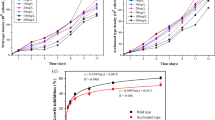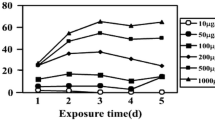Abstract
Nonylphenol (NP) is regarded as a kind of persistent organic pollutant which exists ubiquitously in the environment. The objective of this study was to evaluate the effects of NP on Chlorella vulgaris physiological indices and gene transcription. The results showed that NP stress inhibited algal growth in short-term bioassay. NP also decreased chlorophyll content, including chl a, chl b, and total chlorophyll. NP caused oxidant hurt by overproducing reactive oxygen species (ROS), which might destroy the overall membrane system to cause malondialdehyde content increase. NP inhibited photosynthesis-related gene transcription in C. vulgaris after 24 to 48 h exposure. The lowest transcript levels of psaB, psbA, and rbcL in C. vulgaris decreased to only 18.5%, 7%, and 4% of the control, respectively. Taken together, our results demonstrate that NP is toxic to fresh algae growth by affecting the photosynthesis-related genes transcription and overproducing ROS to disrupt cell structure in a short period.
Similar content being viewed by others
References
Ahel, M., Scully, F. E., Hoigne, J., & Giger, W. (1994). Photochemical degradation of nonylphenol and nonylphenol polyethoxylates in natural-waters. Chemosphere, 28, 1361–1368.
Anonymous (2001). Nonylphenol. Chemical Market Reporter, 260, 31.
Anonymous (2004). Demand increase for nonylphenol in China. Focus Surfactants, 5, 3.
Bokern, M., & Harms, H. H. (1997). Toxicity and metabolism of 4-n-nonylphenol in cell suspension cultures of different plant species. Environmental Science and Technology, 31, 1849–1854.
Bornman, J. F., & Vogelmann, T. C. (1991). Effect of UV-B radiation on leaf optical-properties measured with fiber optics. Journal of Experimental Botany, 42, 547–554.
Burkhardt-Holm, P., Wahli, T., & Meier, W. (2000). Nonylphenol affects the granulation pattern of epidermal mucous cells in rainbow trout Oncorhynchus mykiss. Ecotoxicology and Environment Safety, 46, 34–40.
Christiansen, T., Korsgaard, B., & Jespersen, A. (1998). Effects of nonylphenol and 17β-oestradiol on vitellogenin synthesis, testicular structure and cytology in male eelpout Zoarces viviparus. Journal of Experimental Biology, 201, 179–192.
Correa-Reyes, G., Viana, M. T., Marquez-Rocha, F. J., Licea, A. F., Ponce, E., & Vazquez-Duhalt, R. (2007). Nonylphenol algal bioaccumulation and its effect through the trophic chain. Chemosphere, 68, 662–670.
Corvini, P. F. X., Schäffer, A., & Schlosser, D. (2006). Microbial degradation of nonylphenol and other alkylphenols—Our evolving view. Applied Microbiology and Biotechnology, 72, 223–243.
Cox, C. (1996). Nonyl phenol and related chemicals. Journal of Pesticide Reform/Spring, 1, 15–20.
Giger, W., Brunner, P. H., & Schaffner, C. (1984). 4-Nonylphenol in sewage-sludge: Accumulation of toxic metabolites from nonionic surfactants. Science, 225, 623–625.
Graff, L., Isnard, P., Cellier, P., Bastide, J., Cambon, J. P., Narbonne, J. F., et al. (2003). Toxicity of chemicals to microalgae in river and in standard waters. Environmental Toxicology and Chemistry, 2, 1368–1379.
Halliwell, B., & Whiteman, M. (2004). Measuring reactive species and oxidative damage in vivo and in cell culture: How should you do it and what do the results mean? British Journal of Pharmacology, 142, 231–255.
HELCOM (Helsinki Commission) (2002). Guidance document on nonylphenol/nonylphenol ethoxylates (Np/NPEs). Finland: Baltic Marine Environment Protection Commission.
Hense, B. A., Jüttner, I., Welzl, G., Severin, G. F., Pfister, G., Behechti, A., et al. (2003). Effects of 4-nonylphenol on phytoplankton and periphyton in aquatic microcosms. Environmental Toxicology and Chemistry, 22, 2727–2732.
Hesselsoe, M., Jensen, D., Skals, K., Olesen, T., Moldrup, P., & Roslev, P. (2001). Degradation of 4-nonylphenol in homogeneous and nonhomogeneous mixtures of soil and sewage sludge. Environmental Science and Technology, 35(3), 695–700.
Hill, R. L., & Janz, D. M. (2003). Developmental estrogenic exposure in zebrafish (Danio rerio). I. Effects on sex ratio and breeding success. Aquatic Toxicology, 63, 417–429.
Inskeep, W. P., & Bloom, P. R. (1985). Extinction coefficients of chlorophyll a and b in N, N-dimethylformamide and 80% acetone. Plant Physiology, 77, 483–485.
JME (Japanese Ministry of Environment) (2001). Report on the test results of endocrine disrupting effects of nonylphenol on fish (draft). Tokyo: Environmental Health Department, Government of Japan.
Jubany-Marí, T., Munné-Bosch, S., & Alegre, L. (2010). Redox regulation of water stress responses in field-grown plants. Role of hydrogen peroxide and ascorbate. Plant Physiology and Biochemistry, 48, 351–358.
Kolpin, D. W., Furlong, E. T., Meyer, M. T., Thurman, E. M., Zaugg, S. T., Barber, L. B., et al. (2002). Pharmaceuticals, hormones, and other organic wastewater contaminants in US streams, 1999–2000; a national reconnaissance. Environmental Science and Technology, 36, 1202–1211.
Landolfo, S., Politi, H., Angelozzi, D., & Mannazzu, I. (2008). ROS accumulation and oxidative damage to cell structures in Saccharomyces cerevisiae wine strains during fermentation of high-sugar-containing medium. Biochimica et Biophysica Acta, 1780, 892–898.
Langford, K. H., & Lester, J. N. (2002). Fate and behaviour of endocrine disrupters in wastewater treatment processes. In: J. W. Brikett & J. N. Lester (Eds.), Endocrine disrupters in wastewater and sludge treatment processes. Boca Raton: CRC Press.
Livak, K. J., & Schmittgen, T. D. (2001). Analysis of relative gene expression data using real-time quantitative PCR and the 2 − ΔΔCt method. Methods, 25, 402–408.
Lürling, M., & Roessink, I (2006). On the way to cyanobacterial blooms: Impact of the gerbicide metribuzin on the competition between a green alga (Scenedesmus) and a cyanobacterium (Microcystis). Chemosphere, 65, 618–626.
Lussier, S. M., Champlin, D., LiVolsi, J., Poucher, S., & Pruella, R. J. (1999). Acute toxicity of para-nonylphenol to saltwater animals. Environmental Toxicology and Chemistry, 19, 617–621.
Manzano, M. A., Perales, J. A., Sales, D., & Quiroga, J. M. (1998). Effect of concentration on the biodegradation of a nonylphenol polyethoxylate in river water. Bulletin of Environmental Contamination Toxicology, 61, 489–496.
Naylor, C. G. (1995). Environmental fate and safety of nonylphenol ethoxylates. Textile Chemist and Colorist, 27, 29–33.
Qian, H. F., Chen, W., Sun, L., Jin, Y., Liu, W., & Fu, Z. (2009a). Inhibitory effects of paraquat on photosynthesis and the response to oxidative stress in Chlorella vulgaris. Ecotoxicology, 18(5), 537–543.
Qian, H. F., Sheng, G. D., Liu, W. P., Lu, Y. C., Liu, Z. H., & Fu, Z. W. (2008). Inhibitory effects of atrazine on Chlorella vulgaris as assessed by real-time polymerase chain reaction. Environmental Toxicology and Chemistry, 27, 182–187.
Qian, H. F., Xu, X. Y., Chen, W., Jiang, H., Jin, Y. X., Liu, W. P., et al. (2009b). Allelochemical stress causes oxidative damage and inhibition of photosynthesis in Chlorella vulgaris. Chemosphere, 75, 368–375.
Rioboo, C., González, O., Herrero, C., & Cid, A. (2002). Physiological response of freshwater microalga (Chlorella vulgaris) to triazine and phenylurea herbicides. Aquatic Toxicology, 59, 225–235.
Seki, M., Yokota, H., Maeda, M., Tadokoro, H., & Kobayashi, K. (2003). Effects of 4-nonylphenol and 4-tert-octylphenol on sex differentiation and vitellogenin induction in medaka (Oryzias latipes). Environmental Toxicology and Chemistry, 22, 1507–1516.
Servos, M. R. (1999). Review of the aquatic toxicity, estrogenic responses and bioaccumulation of alkylphenols and alkylphenols polyethoxylates. Water Quality Research Journal of Canada, 34, 123–177.
Sies, H. (1991). Oxidative stress: Oxidants and antioxidants. New York: Academic Press.
Soto, A. M., Justicia, H., & Wray, J. W. (1991). Sonnenschein C. p-Nonylphenol: An estrogenic xenobiotic released from “modified” polystyrene. Environmental Health Perspectives, 92, 167–173.
Staples, C., Mihaich, E., Carbone, J., Woodbrun, K., & Klecka, G. (2004). A weight of evidence analysis of the chronic ecotoxicity of nonylphenol ethoxylates, nonylphenol ether carboxylates, and nonylphenol. Human and Ecological Risk Assessment, 10, 999–1017.
Topp, E., & Starratt, A. (2000). Rapid mineralization of the endocrine-disrupting chemical 4-nonylphenol in soil. Environmental Toxicology and Chemistry, 19, 313–318.
Uguz, C., Togan, I., Eroglu, Y., Tabak, I., Zengin, M., & Iscan, M. (2003). Alkylphenol concentrations in two rivers of Turkey. Environmental Toxicology and Pharmacology, 14, 87–88.
Vazquez-Duhalt, R., Marquez-Rocha, F., Ponce, E., Licea, A. F., & Viana, M. T. (2006). Nonylphenol, an integrated vision of a pollutant. Applied Ecology and Environmental Research, 4, 1–25.
Wang, J. X., Xie, P., & Guo, N. C. (2007). Effects of nonylphenol on the growth and microcystin production of Microcystis strains. Environmental Research, 103, 70–78.
Wu, Z. B., Zhang, Z., Chen, S. P., He, F., Fu, G. P., & Liang, W. (2007). Nonylphenol and octylphenol in urban eutrophic lakes of the subtropical China. Fresenius Environmental Bulletin, 16, 227–234.
Zhou, Y., & Zhang, Z. (1989). The toxicity methods in aquatic living. China: Agriculture Press.
Author information
Authors and Affiliations
Corresponding author
Rights and permissions
About this article
Cite this article
Qian, H., Pan, X., Shi, S. et al. Effect of nonylphenol on response of physiology and photosynthesis-related gene transcription of Chlorella vulgaris . Environ Monit Assess 182, 61–69 (2011). https://doi.org/10.1007/s10661-010-1858-9
Received:
Accepted:
Published:
Issue Date:
DOI: https://doi.org/10.1007/s10661-010-1858-9




